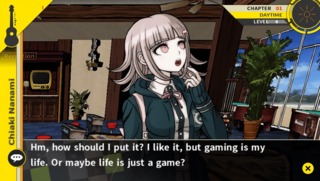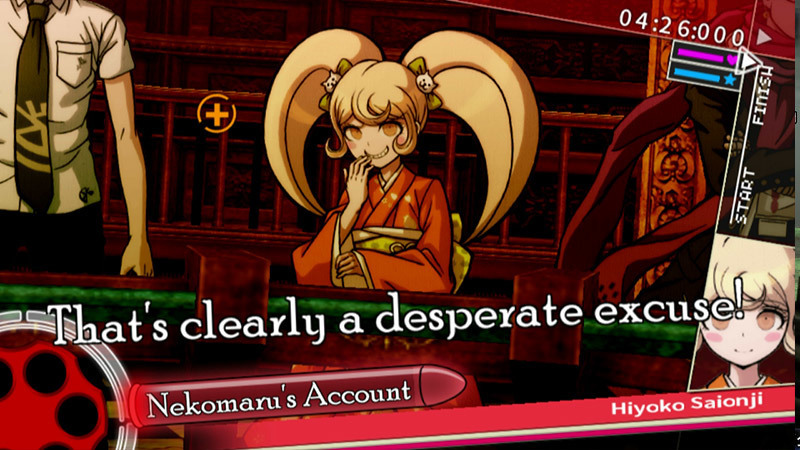If you're surprised to already see a review of Danganronpa 2: Goodbye Despair, you're not experiencing amnesia. Danganronpa: Trigger Happy Havoc was released on Vita earlier this year! Thanks to the extended time it took for these twisted visual novels to come here--they hit PSP in Japan years ago--we're getting them practically back-to-back. It's not a moment too soon, either, given how Danganronpa left us hanging. Danganronpa proved one of the most surreal experiences I've had with a game all year, even if Danganronpa was never able to justify the tacked-on interactive elements meant to make it feel more game-y. Danganraonpa 2 valiantly tries to double down on this idea, but ultimately ends up making the game even less fun to play over time. You're here for the crazy story, which remains the series' strength, and if the shocked reactions to the game's story have you interested, it's a good place to start.

If you're unfamiliar with Danganronpa's premise...well, try to stay with me here. There will be some mild Danganronpa spoilers, but I'm not going to ruin very much. Hope's Peak Academy is a school where the best of the best go to perfect their individual craft. In this world, they're labeled "ultimates," which reflects their particular skill. This can range from Ultimate Pop Sensation to Ultimate Programmer to Ultimate Bike Gang Leader. It's an, uh, eclectic bunch. The school itself is dedicated to studying the nature of talent, explaining its recruiting process. When the students arrive, however, they're immediately knocked unconscious, and wake up in a tattered version of Hope's Peak Academy. Not only are they locked in, but a robotic, sarcastic bear named Monokuma says there are two options. One, the students can live out the rest of their lives in relative peace but never leave. Two, the students can kill one another, and if the murderer gets away with his or her crime, they'll be able to leave, but everyone else dies. You can imagine where it goes from there. In the sequel, it's the same premise, but it takes places on a tropical island. Players are cast into the role of Hajime Hinata, a student who doesn't remember his talent.
At the end of Danganronpa, a few students leave the school. It's not clear what happened to them, and Danganronpa 2 immediately starts playing with this idea, since Danganronpa players will immediately recognize a physically larger version of a returning character. What's he doing here? How come this killing game is playing out a second time? These questions are at the core of Danganronpa 2, and while playing the original will make everything that happens (especially towards the end) more satisfying, the vast majority of the game is playable for anyone who wants to dive into this bizarre series with the sequel.
The game itself is split into three distinct phases of gameplay: free time, investigation, class trial. During free time, players talk with the other students and learn about their backstories. It's a completely optional part of the game, but one that's recommended, as it allows players to discover the motivations behind their favorite characters. Plus, the writing is really goddamn funny, and the more chances to experience the tremendously witty dialogue, the better. Investigation is triggered upon the discovery of a murdered student, and has players exploring and analyzing crime scenes to come up with scraps of evidence for the coming trial. The evidence is written in your handbook as "truth bullets" because you, er, "fire" them at logical contradictions raised during the class trial. I don't care what anyone says, truth bullets is a rad term.

The class trial is where players become the most active, and it's where the series continues to falter relative to other detective games. In a nutshell, players apply evidence gathered during the investigation to figure out the truth. This comes in a variety of forms, but the most common is a conversation between the students in which the game assigns you a stack of evidence to contradict or confirm what's being said. Text scrolls across the screen, and certain words are highlighted while the conversation moves forward. It eventually loops. Everything is timed, though failure means little outside of a grading reduction. You can try over and over again. This starts out straightforward enough, but as the game goes on, the designers figured the best way to elevate the difficulty was to make the text extremely hard to read. It'll shake around, it'll be surrounded by other text. It's frustrating. Not helping matters is one-too-many contradictions that can't reasonably be figured out except through sheer trial-and-error. Danganronpa's interface makes it extremely difficult to consider all your evidence at once, which quickly leads to exasperated guessing.
Despite how messy and confusing the conversations get, they're the best part, and it's satisfying when you nail someone who's got it all wrong. The game will occasionally mix things up with mini-games, including a version of hangman and infuriating takes on a rhythm and platform games. As Danganronpa 2 passed the 20-hour mark, its answers just within reach, I began loudly cursing a game about deduction that was asking me to deal with yet another platforming sequence with seemingly no collision detection whatsoever.
Honestly, I started referencing a walkthrough a handful of times towards the end. I was here for the story, and only the story. There's an option to ratchet down the difficulty of the class trial, and I recommend it. It's too bad, as the most enjoyable twists come during the class trial portion. True motivations are revealed, and the tricky ways various characters pulled off the ambitious murders are part of the fun. As fun as a cartoonish game about a robotic bear forcing kids to murder each other is fun, anyway. Don't judge me!

There are other questionable elements from the original that stick around, too. For a game that otherwise does such a fantastic job of representing a wide variety of personalities and genders in its cast, it regularly goes out of its way to objectify the women under the joking guise of fan service. Akane, the Ultimate Gymnast, regularly busts out of her shirt when angry...for no reason. Compared to the original, what's different here is how it tries to justify these moments by pointing them out. Just because the game is aware of what's happening doesn't make it okay, though maybe it suggests a localization team aware of the issues. It's particularly egregious for one character who constantly finds herself tripping into the most exploitative positions, and the game laughingly pointing it out. The game tries to layer another set of justifications during the class trial, leveraging it as a piece of evidence, but it was no less ridiculous. It adds nothing.
Danganronpa 2 manages to match the madness of the previous game. In many ways, it purposely ups the ante, giving players plenty of reason to re-read old dialogue and consider previous situations in a new light. In the final hours, there are plenty of head-slapping a-ha moments that make the slightly too lengthy and murderous journey worth the ride. This is a series that takes joy in tricking the player, and not necessarily by laying out evidence along the way. The twists in Danganronpa are often out of left field, and so long as you're okay with the game constantly pulling out rugs, you're in for a good time.
Whether that madness is ultimately satisfying is another question. So much of Dangranonpa 2 is an immediate, purposeful retread in both mechanics and storytelling. That loses its charm after a while, especially when the credits begin rolling, and it becomes clear not much has ultimately advanced after the events of the original game. A similar problem plagued the equally-out-there Zero Escape series also produced by Chunsoft. This is a fun sequel spinning its wheels, capitalizing on what worked well before without real progress towards an endgame. Like most sequels, that works once, but it won't a third time.